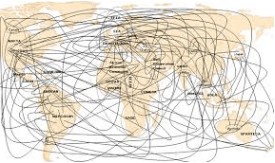
The Productivity Commission (PC) has issued a warning about potential deleterious costs for competition and business stemming from Australia’s so-call “free trade agreements” (FTAs). From The AFR:
“Trade agreements can distort comparative advantage between nations and consequently reduce efficient resource allocation”…
Building on its 2010 report which found the benefits to national income accruing from bilateral and regional trade agreements was likely to be modest, the report says another weakness is rules of origin.
“Such complexity adds to the compliance costs for firms engaging in trade . . . the origin requirements and the complexity of rules are likely to impede competition”…
The PC has essentially touched upon the two key hidden costs commonly associated with preferential FTAs: 1) trade diversion; and 2) complex rules of origin.
Trade diversion arises when the importing country shifts its buying from a more efficient, lower cost country whose goods are subject to a tariff towards the less efficient and higher cost FTA partner, whose goods are not subject to a tariff. In such circumstances, the importing country loses the tariff revenue, whilst its consumers do not fully benefit from a price reduction, potentially making the nation worse-off as a whole.
In order to explain, consider the below stylised example.
Country A imposes a 10% tariff on motor vehicles and, prior to the FTA, imports these vehicles at a cost of $20,000 from the World, taking the total import cost to $22,000, and earning its government $2,000 per vehicle in tariff revenue.
Country A then negotiates an FTA with Country B, who is less efficient at producing motor vehicles, and can produce a virtually identical car for $21,500.
After the FTA is concluded, Country A shifts its car purchases from the World to Country B. As a result, the total import cost of motor vehicles into Country A falls to $21,500, providing consumers with a benefit of $500 ($22,000 less $21,500). However, the government loses $2,000 in tariff revenue, making Country A worse-off overall.
Obviously, this is simple stylised example only, designed merely to highlight one of the potential costs of FTAs via trade diversion. But these efficiency costs can be real, especially when FTAs are negotiated with parties that are not world’s best producers in goods and where high tariffs exist (e.g. clothing and footwear).
Rules of origin (ROO) are designed to stop imports coming from third party (non-FTA) countries via an FTA partner, in order to circumvent tariff requirements. The ROOs, which can be either based on value-added requirements (i.e. the percentage of value-added by the FTA partner) or product specific (i.e. individual rules for each individual product imported), can raise administrative costs for businesses (including complying with paperwork requirements) and custom services in administering and auditing the ROO, undermining the benefits from the FTA.
The costs associated with ROOs will be greatest where there is a large number of FTAs each with different requirements, resulting in a “spaghetti bowl effect” of increasing complexity.
Of course, there are other potential competitive distortions that can arise from binding rules within an FTA. For example, the Australia-US FTA, concluded in the mid-2000s by the Howard Government, saw the inclusion of non-trade provisions, such the extension of patent and copyright terms, which will lessen competition and increase costs for Australian consumers over the longer-term. The Australia-US FTA also saw large chunks of agriculture carved-out, draconian price-based safeguards protecting US horticulture (see Annex 3A), as well as complicated product ROO numbering hundreds of pages.
The Trans-Pacific Partnership (TPP) – the proposed regional trade deal between 12 Pacific Rim countries – also poses dangers to the competitive landscape. As uncovered by WikiLeaks, the TPP risks establishing a US-style regulatory structure that would hand considerable power to US pharmaceutical and digital firms, limiting choice and raising prices for consumers in Australia.
The bottom line is that the Government’s FTA agenda offers modest trade benefits if executed well. However, it could equally result in poor outcomes if the Australia-US FTA approach is adopted, and deals are signed for political rather than economic reasons, without due regard for longer-term consequences.
This is why Australian trade policy and trade liberalisation needs to be viewed as a form of domestic competition policy, rather than something that can be traded away for a bunch of questionable bilateral deals with spurious efficiency impacts.

